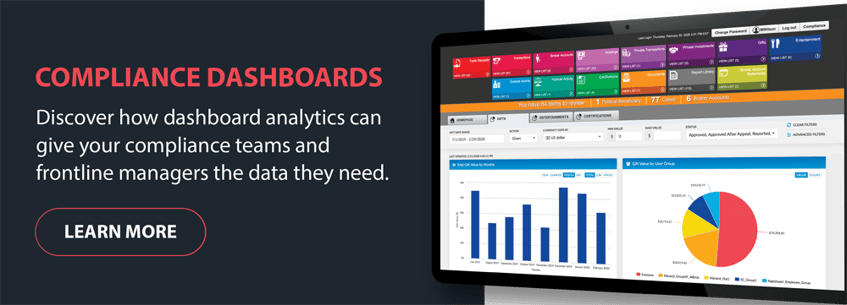Embedded analytics are coming to the rescue of increasingly overstretched compliance departments
The 2008 financial crisis resulted in new regulations worldwide, along with more stringent enforcement of existing ones. This sudden attention from regulators—and financial services firms genuinely looking for ways to reduce risk—meant compliance budgets increased dramatically, which lead to an increase in the size of compliance departments. This growth meant compliance could stay comfortably on top of risk and regulations.
Fast forward to the last few years, and spending on compliance at big firms has either slowed significantly or leveled off. A 2019 report on the compliance function from the consulting firm McKinsey noted most banks are reporting that "compliance [spending] would remain at or near 2017 levels." The pace of new regulation isn’t slowing down, either. And regulators around the globe are seeking more accountability from those who sit outside the compliance department to ensure risk is being properly monitored and mitigated. So if you can't hire more people to keep up with an ever-increasing amount of regulation and enforcement, what do you do? How do you get proper oversight and risk mitigation out of the same number of compliance officers?
DASHBOARDS TO THE RESCUE
This is where dashboards come in. Embedded analytics. Systems that surface critical compliance data automatically, package and present it in an easily digestible, easily consumable format, and make it available farther down the company hierarchy—all the way down to what's often referred to as "the first line of defense." This means supervisors: those members of management who are closest to the general employee population and who—thanks to dynamic dashboard analytics and the near-real time data they provide—can take on some of the more basic compliance oversight work that could only previously be done by compliance officers.
"Compliance teams are facing an increasing number of regulations, and an increasing number of roles they have to fill. They can't just keep getting bigger, so they have to be more efficient." So offers Ryan Sheridan, Star's Executive Director Of Product, and one of the key people behind Star's own push to develop and deploy dashboard analytics." A team of ten compliance officers having to do everything for a firm of 50,000-plus people is unrealistic. With dashboard analytics, the idea is to identify the tasks that can be pushed down to supervisors and give them the data they need to conduct oversight of their direct reports. If supervisors can take more of an active role, it reduces the compliance workload on the compliance team itself."
While some of this data being pushed to the first line of defense via dashboards may have always been available somewhere in your compliance platform, it's probably been difficult to get at, requiring a lot of manual effort and manipulation to get it to where it's useful from a compliance-monitoring perspective. You're pulling the data out of the system manually. Doing a lot of manipulation in Excel. You've figured out some clever tactical solutions, to get it usable and consumable, but it's still a big lift. And because of the time and lift this endeavor takes, it's probably being done too infrequently and in a piecemeal, incomplete manner—leaving room for risk. Dashboards save you hours or even days of collection work, leaving compliance officers and supervisors to focus on the unarguably more important work: data and trend analysis.
Sheridan: "If you're not able to get the complete picture, you're not really solving the problem. Maybe you don't trust the data, having had to pull it together in an improvised fashion. With dashboards, you know the data is accurate and will remain accurate, as it will be updated frequently."
Dashboards also put this key data directly in front of those who need to see it, be it compliance officers or employee supervisors. "Our dashboards will appear in the existing STAR Platform," says Sheridan, "the interface our clients and end users know so well, and are comfortable getting around in. They'll be easy to use, with master controls at the top that let you slide and dice the data, which will subsequently change all of the analytics you see. Date range. Action. Currency. You can adjust your min-max values, which then affects all the reports on the page. Sometimes you don’t know what you're looking for until you see it, and so it’s important to be able to filter and shape the data in different ways and have the dashboards immediately respond."
SHOW ME THE ANALYTICS
Aside from a decreased workload for compliance teams—a significant achievement in and of itself—one of the byproducts of pushing data down the line is risk reduction. Employee managers are going to be a lot more effective at spotting patterns, trends, and unusual behaviors because they know their direct reports better than a compliance officer—operating at a necessarily higher level—ever will. Due to this proximity, managers will also be able to react to potential problems more quickly, and can have a more direct impact on spotting and preventing future issues. This secondary effect has, in and of itself, become a driver of the industry-wide trend to move some compliance oversight authority down and away from a centralized compliance team.
Another driver of this trend is accountability. Regulations calling for more accountability from financial firms and their senior managers are on the rise. In the UK there's the Senior Managers & Certification Regime, or SMCR. In Australia it's the Banking Executive Accountability Regime, or BEAR. In a nutshell, what regulators are saying in their accountability regulations is: "You've had compliance issues in the past, but when we visit no one feels they're actually accountable, because they didn't know they had that responsibility." So part and parcel of these regulations is getting managers to sign up to all their roles and responsibilities, and therefore make them undeniably accountable. But those managers need genuine visibility into the actions of their organization if they're to be held accountable for them. Dashboards offer this visibility.
Again, Sheridan: "Regulations surrounding accountability are only going to become more prescriptive. It's likely you'll eventually have to evidence you've collected the proper data, and explain how you got it. With embedded analytics, you’ll be able to simply demo the dashboards. Data visibility and accountability go hand in hand when it comes to financial compliance, at every level of the organization, and are at the heart of dashboard analytics."



